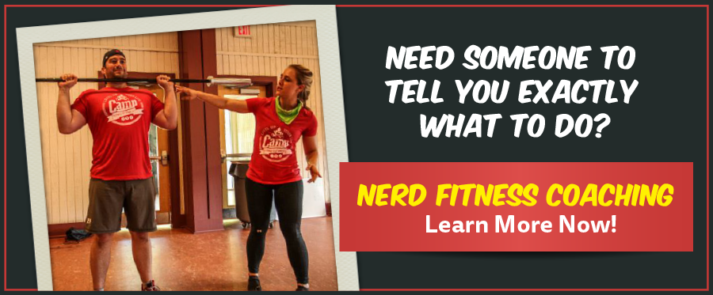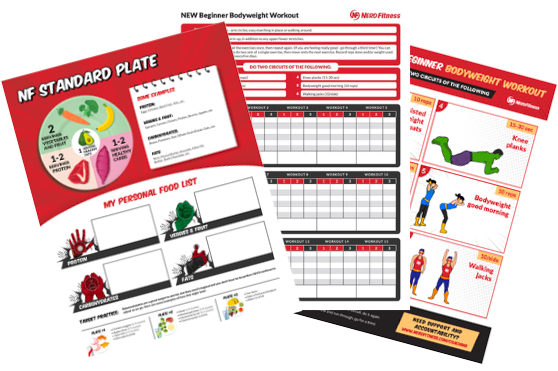
Want to build muscle like this guy?
(Leopard print unitard optional but encouraged)
In this guide, we’ll provide step-by-step instructions that will help you start building muscle immediately. Like, today.
We’ll explore:
- How do you build muscle?
- What’s a sample routine for muscle training?
- How many sets and reps should I do?
- Muscle training weightlifting tips.
- How many calories to eat to build muscle? (and which supplements)
- Will I get too bulky lifting weights?
- Can you lose weight and gain muscle at the same time?
- Rest days for building muscle and strength.
That may seem like a lot of topics to cover. DON’T PANIC!
If you want to build muscle, get bigger, and become stronger, it comes down to three things done consistently:
I realize doing those three things is much easier said than done. Doing hard stuff consistently for months and years requires a great strategy!
In addition to the free resources below, we provide a free bodyweight routine, and a comprehensive gym training routine to get you started with strength training in our free guide, Strength Training 101: Everything You Need to Know. Grab your guide when you sign up in the box below:
How Do You Build Muscle and Strength?
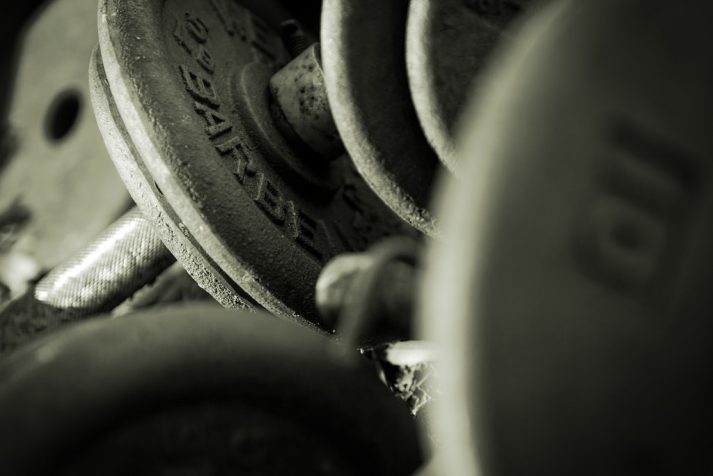
If you are going to build strength and muscle, you need to lift heavy things to force your muscles to rebuild themselves stronger.
But what the heck does ‘heavy’ mean in this context? I’m so glad you asked!
Muscle-building is optimized when performing strength-training exercises (bodyweight or weightlifting) within 1 to 3 reps of failure while maintaining good technique.
(i.e. You could do 1 or 2 or 3 more repetitions of the exercise using a specific weight, but not more.) Usually, you’ll repeat this effort for multiple sets targeting multiple muscles in a workout.
That’s what I mean by ‘lift heavy’: you picked the right amount of weight to challenge yourself for the desired number of reps. By forcing your muscles to really tax themselves by picking up heavy things, you are participating in the Holy Grail of muscle building: progressive overload!
Progressive overload: forcing your muscles to rebuild themselves stronger by increasing the challenge they face with each workout. Examples include: lifting heavier weight, doing more reps, frequency, decreased rest, etc.
For example, from one week to the next, progressive overload would look like:
- Week 1 Barbell Squat: 4 sets of 6 reps at 150 lbs.
- Week 2 Barbell Squat: 4 sets of 6 reps at 155 lbs.
If you do that, you’ve gotten stronger! Then, repeat next week. Consume enough calories and protein, and you’ll get bigger too.
“Got it, Steve. I need to pick up heavy things. Can we talk about which exercises I should do to build muscle?”
Great question, you good looking person. I’ll cover specific exercises in the following section, but let’s start with a broader point:
Free weights, machines, and bodyweight exercises are ALL good options as long as you can adhere to the guidelines we laid out above. [4]
While you can grow muscle using any type of strength-training exercise, having access to a gym with free weights and weight machines makes leveling up your muscle-building game all the easier.
Check out our Beginner’s Guide to the Gym for everything you need to know and getting started in a gym with sample workouts.
So let’s start building muscle!
We’ll want a routine with compound exercises that train multiple muscle groups at once. They’re efficient and they can create solid growth and stimulation.[5]
To create our full-body routine, each workout will make sure it has a big compound leg exercise, push exercise, pull exercise, and a core exercise:
- Leg Exercises (Quad Dominant or Hip Dominant): Squats, Deadlifts, or Lunges
- Push Exercises: Bench Press, Overhead Press, or Dips
- Pull Exercises: Inverted Rows, Pull-Ups, or Chin Ups
- Core Exercises: Reverse Crunches, Hanging Knee Raises, or Ab Mat Sit-ups
Learn these few exercises, get really good at them, and your entire body will get stronger and bigger. Focus each week on adding more weight to each exercise.[8]
Bottom line: if you want to get bigger muscles, you need to challenge them regularly with exercises that bring the muscle close to failure (1 to 3 reps). To start, we recommend picking big, compound movements that work multiple muscles at a time.
“Steve, what about isolation exercises like bicep curls, tricep extensions, calf raises, etc.?”
Absolutely add these in whenever you want to, though we recommend starting with the workout we laid out above FIRST and getting consistent with that. Muscle-building isn’t just about picking the right exercises and the right weights, it’s about building the habit of working out!
If you try to do ALL THE THINGS at the very beginning, you’re increasing the risk that you won’t be able to make the habit stick.
Start with compound exercises that give you the biggest bang for your buck, THEN sprinkle in isolation exercises that target your specific areas of need. [6]
“What about machines versus free weights? I’ve heard free weights are better…”
Not true! If a machine exercise feels safer, is more easily accessible to you, and targets the same muscles – go for it. The important thing is that you are challenging your muscles to get stronger, that’s it. [7]
What’s a Sample Routine for Building Muscle?
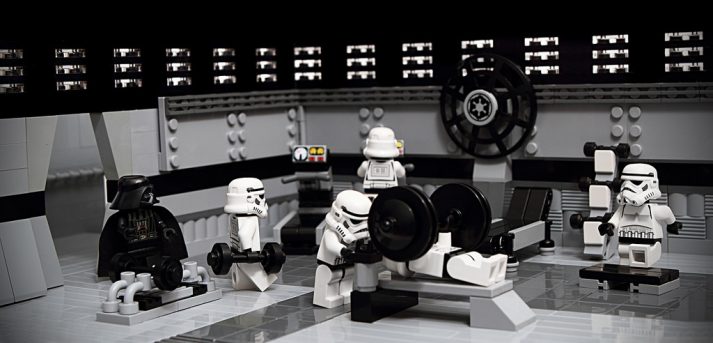
Using the principles I’ve laid out in my “how to build a workout routine” article, here’s a beginner three-day routine:
- Monday: Squats, Benchpress, Wide Grip Pull-Ups, Ab-Mat Sit-ups
- Wednesday: Deadlift, Overhead Press, Inverted Rows, Hanging Knee Raises
- Friday: Weighted Lunges, Weighted Dips, Weighted Chin-Ups, Reverse Crunches.
Each day has a leg exercise, push exercise, pull exercise, and some core work.
Besides having rest and recovery days in between MWF, adequate rest intervals have been established in the workout itself!
By following the leg exercise, push exercise, pull exercise, and core exercise routine you will maximize rest in-between each exercise, therefore, limiting muscular fatigue and allowing you to perform each strength training exercise to its fullest extent.[9]
Now, this is just a basic, 3-day, Full-Body workout routine. We have a whole guide on how to build your own workout, but there are infinite ways to build a strength training routine.
4-Day Push-Pull split[32]:
- Monday: Push exercises
- Wednesday: Pull exercises
- Friday: Push exercises
- Saturday: Pull exercises
4-Day Upper Lower Split:
- Monday: Lower Body
- Wednesday: Upper Body
- Friday: Lower Body
- Saturday: Upper Body
Bodybuilders often prefer to follow a 5-day “each day gets one body part” workout[33]:
- Monday: Legs (quad dominant)
- Tuesday: Chest
- Wednesday: Back
- Thursday: Legs (hip dominant)
- Friday: Arms
Each routine has positives and negatives, is dependent on how often you can work out, and each is based on your preference! As long as your muscles are being forced to rebuild themselves stronger, it’s the right workout for you.
While it’s possible to build out the perfect routine on your own, many of our Rebels end up spending hours and hours building something custom – only to realize it isn’t what they need (or isn’t effective) weeks and months later for their goals.
For people who want to avoid that altogether, we built the solution – our uber-popular 1-on-1 coaching program pairs you with your own Nerd Fitness Coach who will get to know you, your goals, and your lifestyle, and handcraft a workout plan that’s specific to your body, your schedule, and your life.
Click the image below to schedule a call with our team to see if we’re a good fit for each other!
How Many Sets and Reps Should I Do?
We have a MASSIVE guide on the exact number of sets and reps (it’s where the video above comes from), but you can follow the basics here.
- For beginners, we recommend starting in the 5 – 15 reps range to increase both size and strength. (If you want to focus on more strength than size, stick to the lower end of that range.)
- As you get more advanced, you may find that it’s beneficial to do up to 30 reps of an exercise. (Though 90% of your work will still be in that 5 – 15 rep range.) The biggest drawback to higher rep ranges like this is it can be hard to target specifically that “1 to 3 reps before failure” when the rep count is so high. [10] [11]
The good news is that no matter which path you take (pure strength, size, or a mix of both), as long as you are adding weight each week – and eating enough – you WILL be getting stronger.[12]
ANY path will work, provided you are progressively overloading your muscles with an increased challenge!
Coach Jim explains it all for you right here:
Progressive overload involves exerting slightly more effort than last time (lift a heavier weight or do 1 more rep) consistently.
Your muscles will have to adapt and rebuild themselves to get stronger. So in order to see improvements, your training must gradually and constantly increase.
We just have to make sure we get the right pace!
According to Mike Rebold, PHD, a professor from from Hiram College:
Keep in mind that if the overload increases too quickly, poor technique and injury may result. And if the overload progresses too slowly, improvements will be minimal or non-existent.
Slowly but gradually increasing your challenge could look like:
- If you do 5 sets of 5 squats at 140 pounds this week, aim for 5 sets of 5 of 145 pounds next week.
- Or if you’re doing 3 sets of 10 at 100 pounds, then next week try for 3 sets of 10 at 105 pounds.
Get stronger, which is 20% of the puzzle. The other 80% is nutrition (which I cover later)!
As I said before, if you want even more info, you can head to our article “Determining the Correct Number of Reps and Sets” for a deep dive into the subject.
7 Muscle Building and Weight-Lifting Tips

#1) Warm-up before exercising – don’t walk into a gym, slap 45-pound plates on the bar, and then start your routine.
Get your heart rate up and muscles warm first by doing a dynamic warm-up of jumping jacks, lunges, bodyweight squats, hip raises, push-ups, leg swings, jumps, etc.
After that, always start with doing a set or two of lifting JUST THE BAR.[13] Only then should you start adding weight for some warm-up sets before moving into your work sets.
#2) Have a focused form – if you’re doing a bodyweight squat incorrectly, you might develop bad habits.
However, if you do a barbell squat incorrectly with 405 pounds on your shoulders, you could do some serious damage. If you’re just starting out, check your ego at the door: start with a VERY light weight and make sure you are doing the exercise properly.
There is NO SHAME in starting with just the bar. You can always add more weight next week if this week is too easy.
#3) Stimulate, don’t annihilate – I try to always have one more rep left when I finish a set.
Some trainers will preach working your muscles to annihilation, but I think that’s just asking for an injury, poor form, and beyond-sore muscles.
Your muscles get built while resting, not in the gym, so don’t worry about destroying them completely each day you step in the gym – it’s not worth it.[14]
#4) Change up the time between sets – if you’re doing 3 sets of 5 reps of a really heavy weight, it’s okay to wait 3-5 minutes between sets – you’re focusing on pure strength here.
If you’re doing sets in the 8-12 range, try to keep the time between sets around a minute or so. This will affect your muscles in different ways. The most important thing is to rest long enough that you can give the same level of effort as you did in the previous set.
For more, learn all about sets and rep ranges.
Just be consistent between sets and when doing the same workout between weeks to track your progress.[15]
#5) Don’t overdo it – More does not mean better in weightlifting. You don’t need to spend two hours in the gym, you don’t need to do 15 different kinds of chest exercises.
My routines last no longer than 45 minutes, I only do three or four sets (after warm-up sets) for each exercise, and it’s enough to stimulate muscle growth. I only need to add more if my growth plateaus or stops, and before I do that I make sure my intensity, diet, and recovery are dialed in FIRST. [16]
Three workouts a week is a great place for most to start – we’ve had clients build muscle on anywhere from 2 days a week to 4 days a week using a full-body routine like this! You need to give your muscles time to regrow bigger – remember muscles are made in the kitchen![17]
Less is often more – just make your routines really intense and exhausting.[18]
#6) Write down everything – Keep a training journal, and write down exactly how many sets and reps you did for every exercise.
That way, you can compare how you did this time with how you did last time. You’ll know how much more you need to lift this week to make sure you’re stronger than last week.
#7) Follow a routine, have a plan and stick with it for months and months. We are training our muscles to get stronger and stronger, so you’ll get the best results if you can fall in love with the boring process of doing the same workout – but lifting heavier weight for months and years. [19]
I’ve been doing squats, pull-ups, deadlifts, and presses once a week, every week for 24 years. The sets, reps, and weights have changed, but the workout is largely the same. I don’t need to be entertained by the workout, I’m excited about, “how much weight can I lift?!”
HOw Many Calories Should I Eat To Gain Muscle (and Which Supplements)

If you’re skinny and trying to bulk up, this will be 90% of the battle.
If you’ve been lifting weights for a while “but can’t seem to gain weight,” then you are not eating enough. To gain weight, you’re going to need to seek a calorie surplus (i.e., hypercaloric diet). This usually consuming an additional 250-500 kcal/day or 10-20% above your typical diet. [20]
I thought I was one of those people who just could never gain weight, even after training hard for 6 years…and then I learned it was all diet, started eating 3500+ calories a day (lots more liquid calories, rice, bread, oats, and potatoes!), and I put on 18 pounds in 30 days.
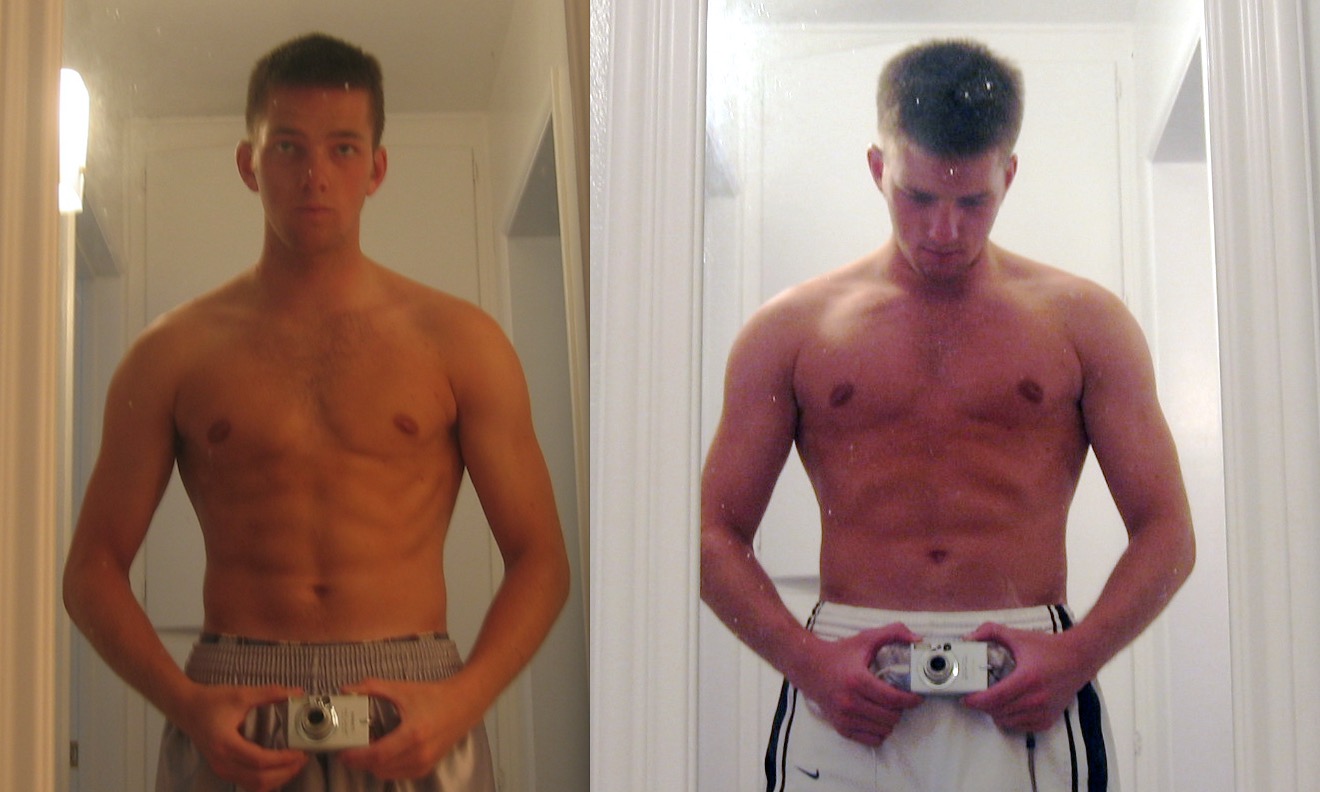
After 6 years of exercising without putting on any weight, it was great to see so much progress in such a short period of time.
I’ve since changed my strategies and have become more calculated in my approach. It’s how I (jokingly) went from Steve Rogers to Captain America.

So, as a former super skinny nerd who finally realized “it’s the calories, dummy,” here’s the 3 step process for nutrition when it comes to building musscle:
PART #1: Eat More – To gain weight, you’re going to need to seek a calorie surplus (i.e., hypercaloric diet). This can be achieved by consuming an additional 250-500 kcal/day or 10-20% above your typical diet.
You can get an estimate of how much you need to eat to just MAINTAIN your weight in our free calculator here.
I’m not clairvoyant (yet), so I’m not sure how you’re currently eating. But if you’re looking to add more calories, there are 3 key places to look:
- Adding more carbs: rice, bread, pasta, oatmeal, cereal, potatoes, and any other calorically dense food!
- Adding more fats: avocado, olive oil, nuts, seeds, cheeses, nut butters.
- Drinking more liquid calories: protein shakes (covered below), juice, milk, weight-gain shakes, etc.
Besides just seeking a calorie surplus, it can help for many reasons to pay attention to your macronutrient (e.g., carbohydrates, fats, and protein) consumption.
If you want more specifics on what foods to eat and how to structure your diet for bulking up, check out our Bulk like the Hulk guide!
PART #2: Eat enough protein – With all the hard training you’re doing, you want to not only gain weight but make sure your body has the resources to turn as much of that weight as possible into muscle.
That’s why we put together this handy protein calculator for you – so you can maximize your gains! For most people, targeting between 0.7-1.0g/lb of bodyweight gets you in the optimal muscle-building range.
In our Protein 101 Guide, we talk about sources of protein and simple ways to include more in your diet. If you’re not used to eating a lot of protein, that can be a struggle!
“Which Supplements Should I Take to Build Muscle Quickly?”
As we lay out in our Nerd Fitness Supplement Guide, most supplements are a waste of money and completely unnecessary for building muscle.
However, there are two supplements that CAN BE helpful in building muscle quickly:
- Protein Shakes: If you are struggling to hit your protein and calorie intake goals for the day, adding in a high-calorie protein shake can be a game-changer.[23]
- Creatine Supplements: Creatine helps your muscles retain water and can improve your performance, allowing you to push harder, for longer, in the gym.[24]
Are you vegan and trying to build muscle? Read our full article on how to go plant-based properly![25]
Bottom line: If you don’t see any change, then you need to eat more.
- Yes, it will feel excessive.
- Yes, you will feel full all the time.
- Yes, it’s a pain in the ass and expensive.
But if you really want to be bigger, then you are going to need to really dedicate yourself in the kitchen.
Unless you’re a genetic mutant, it’s incredibly tough to build muscle and strength without overloading your system with calories and nutrients.
Just keep eating.
Won’t All of This Eating Make Me Fat? I Don’t Want to Get Bulky.

I have amazing news: as somebody who has been trying to get “too bulky” for 20 years, it’s unbelievably difficult for a naturally skinny person to suddenly get too bulky.
Yes, you will put on SOME fat along with the muscle you’re building if you’re running a calorie surplus.
This is why picking the right amount of calories per day is important:
- If you can build muscle at 3,000 calories, but you’re eating 4,000 calories, you’ll put on a pound or two of fat per week along with your muscle.
- However, if you need to eat 3,000 calories to build muscle and you’re only eating 2,500, you won’t see any changes.
Everybody is different, so you need to experiment and find out what works best for you.[27]
Once you get to your desired weight (actually, aim for about 10-15 pounds heavier than your goal weight), you can scale back the calories, add in some extra sprints to the end of your workout, and keep lifting heavy – the muscle will remain, the fat will disappear, and you’ll be left with the body you want.
I’m not skinny, I need to LOSE weight – what’s different for me?
As Coach Matt explains above, you can actually build muscle and lose body fat at the same time.
You just have to be careful about how you do it.
We cover the subject in depth in the post, “Can You Lose Fat and Gain Muscle at the Same Time?”:
If you are eating enough protein, and have decent fat stores to pull from for energy needs, you can build muscle even while in a caloric deficit.
As long as you are resting (next section) and strength training (previous section), you can shed body fat while still putting on muscle.
Now, this only works if you have plenty of fat stores to pull from. Once you start to lean out a little, you’ll likely have to increase your calories to start putting on more muscle.

I recently added some strength (and muscle) while losing 22 pounds in 6 months.
Just remember, you can build muscle while losing weight if you:[28]
- Sustain a caloric deficit
- Lift heavy
- Prioritize protein
- Rest
Let’s talk about that last one for a bit.
Rest Days for Building Muscle and Strength
As Coach Jim mentions in the video above, if you’re skinny and trying to bulk up and build muscle, avoid cardio like the plague (also avoid the plague).
Why?
Take a look at the best marathon runners in the world, and compare their physique to somebody like Usain Bolt, the best sprinter in the world – tons of muscle, power, and a body to envy.

There’s nothing wrong with EITHER body – we’re all awesome and are special and blah blah blah.
But you’re reading an article about how to build muscle fast, right? So focus all of your effort on building muscle![29]
You want all the calories you’re consuming to go towards “building muscle,” and not “fuel my run.”

I will admit that I’m biased against chronic cardio, but mostly because it bores me!
You can be far more effective when you focused on getting stronger and only do ‘cardio’ on things you enjoy – after all, your success will largely depend on your nutrition, NOT your cardio!
If you’re lifting heavy, and eating enough, make sure you’re also getting enough sleep! 5-6 hours a night isn’t going to cut it – you need to get at least 8-9 hours of sleep per night for optimal muscle-building. Take naps too if you have the opportunity.
Sleep needs to become a priority, because while we’re asleep, growth hormone, a hormone responsible for regulating muscle growth is released.[30]
If you’re a big guy/girl trying to slim down, a little extra cardio might speed up your fat loss but if you’re not eating correctly, it might result in losing some of the muscle you already have.
Don’t worry about going for 10 mile runs on your off days – do 20-30 minutes of intervals or go run hill sprints in your park. The weight will come off more slowly, but you’ll only be losing fat, not fat AND muscle.
Once you hit your goal weight and the target amount of muscle mass, I’d recommend adding back in some cardio for your overall conditioning, but keep it varied (sprints and intervals). The focus is to keep building explosive muscle and not long, slow, boring muscle.
If you love going for long runs and aren’t going to give that up, I’m not gonna stop you. Just know that the long hours of cardio will severely inhibit your progress on building strength and size.[31]
Get Started Building Muscle Today

This is a basic overview to get ya started. It really boils down to a few major things:
- Lift heavy
- Eat lots of good food
- Rest
Simple to understand, tough to implement.
Trust me, I know – I’ve been battling this for the past decade.
If you made it this far, and you want more specific instruction, here’s how Nerd Fitness can help!
If you are somebody that wants to follow a tailor-made program designed to build muscle and grow strong, check out our popular 1-on-1 Online Coaching Program.
You’ll work with our certified NF instructors who will get to know you better than you know yourself, check your form, and program your workouts and nutrition for you.
-Steve
PS: Be sure to check out the rest of our Strength Training 101 series:
- Strength Training 101
- Strength Training 101: Equipment
- Strength Training 101: Finding the Right Gym
- Strength Training 101: Where do I start?
- Strength Training 101: How much weight should I be lifting?
- Strength Training 101: Inverted Rows
- Strength Training 101: How to Squat Properly
- Strength Training 101: The Overhead Press
- Strength Training 101: The Deadlift
###
All Photo Sources are found right here.[32]


